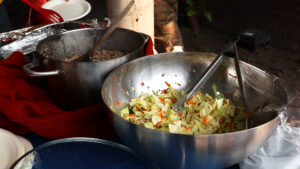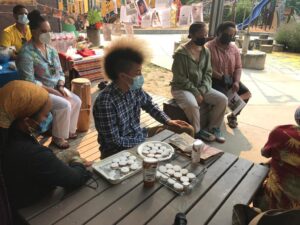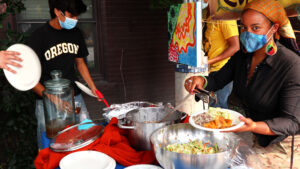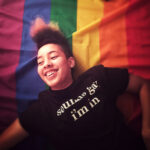Q: What do you hope the kids that you are teaching will do in the future with what you have taught them?
A: Yeah, I learned that when I’m teaching bomba I am opening a window to each person to search who they are, and that’s what I love. In one of my classes in La escuelita I made a carnival dedicated to all families culture and two students learned that their culture has drums from India and they started asking their parents who they were, what their culture was and these were just kids in pre k (only 4-5 years old) and their parents started explaining their culture and traditions. Kids had to talk about the theme of the month (“who am I?”) so they needed to research about their culture and find their story from the elders, find their culture from the families. Their parents were amazed. For example, a kid wanted to dress like an Indian woman so I brought an Indian dress and she was so happy. Another child knew that the grandma from her dad’s side was related to India too so she had an Indian family line and both were dressed like Indian women and singing songs in their language. That is what I wanted: kids learning more about who they are and making research. I never wanted other kids to just know my culture, I also want them to know about their own and to connect with their people so they can get to know themselves better. I connect kids within the same culture to create one big family.
Q: I wish I had you as my teacher while I was at La Escuelita, that would have been so much fun!
A: Yes I love the kids and they love me. I always have fun with them. We watch videos, play music, do choreographies and more.
Q: Cool. Speaking of elders and grandparents, do you know what your family background is? Like your grandfather and great grandparents.
A: My father was a photographer and I kinda say that I am a photographer but I didn’t study it as a profession although I have loved photography since I was a kid and I have a collection of vintage cameras in my house.
I love cameras. I love the beauty of the machine. My grandfather was also a photographer. He loved bicycles too. He used to travel by bicycle in New York, get on a train and get off and keep bicycling, and my father also loved bicycles so it’s like this connection from my elders. My grandfather loved to tell stories and he used to speak a lot with my dad.
When I was a kid, my dad used to put me in the bathtub and make a show for me: he had two different characters and played changing one to another one, changing voices and playing with me… I like stories. One of my projects is to make a story book about storytelling. In the classroom I created a story about something that we need to teach the kids: don’t throw tantrums, don’t push, don’t fight, so I made stories right away in circle time with the white board and drawing and everything. I want to do it for everybody.
Q: Can you talk more about the different styles of Bomba?
A: In Santurce we have four basic rhythms: Sicá, Cuembé, Yubá and Holandé. They are the same rhythms in Mayagüez, and the only difference is that we sing in Spanish in the south and they sing in French in the north west. One of the popular song in Mayaguez that I learn is : Sepulate
Yubá rhythm is a 6/8, the most Afrodescendent rhythms. In the South, Ponce, Guayama, Arroyo, we have Leró, Cunyá and Cuembé, but it is pronounced with “G” Güembé. For me the most interesting thing is that on the entire island the buleador drum do the same thing, it keeps the rhythm and pattern but when they play they mute some of the sound. Technically there is the same rhythm but when you play it sounds different.
Another instrument, the cuá, consists of two sticks. When I started to learn bomba I realized that cuá is the one keeping the pattern and you have to learn how to mute it.
In the south you need to learn how to play the cuá and then the drums. In the South everything is not so technical as in Santurce. The maracas are the instrument that the singer plays but you need to learn them all, so when you play the buleador you have already passed through the basic steps, and know how to play the maracas and how they sound on each rhythm, to be synchronized.
Q: In the process of learning bomba, did you also learn music theory?
A: My first instrument was piano. I learned to play piano and used to read music, but now it is like Chinese for me. I would like to re-learn again. I used to have a piano and when I moved to Seattle I gave it to the school for the kids. I have a lot of instruments in my house like a cello, ceramic drums, and a guitar and I want to learn how to play all of them.
Q: Have you ever lost the motivation to play music?
A: I will never lose the motivation to play music.
















